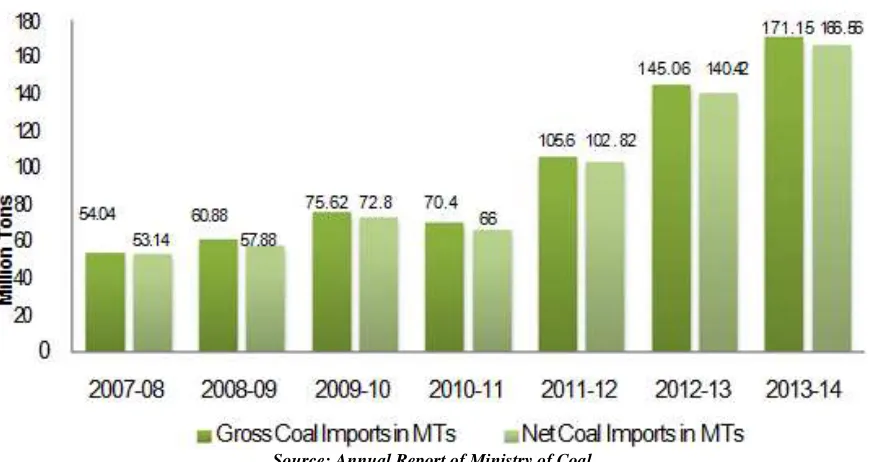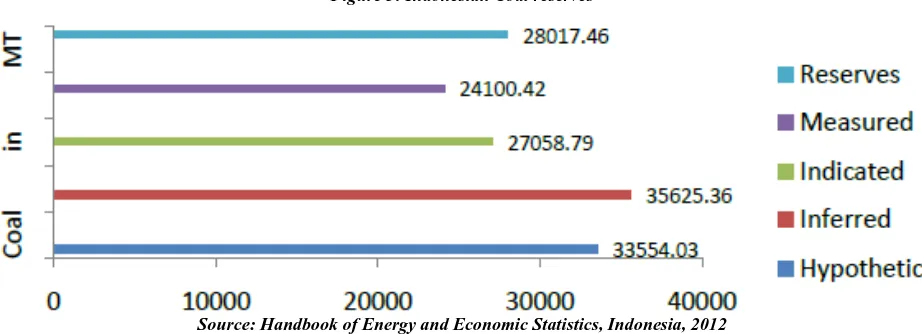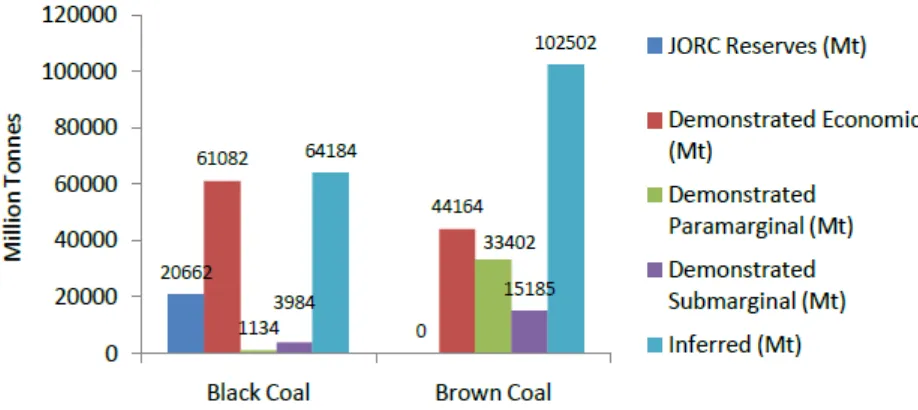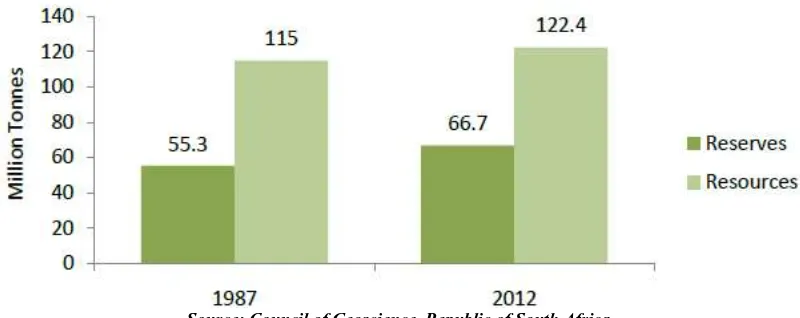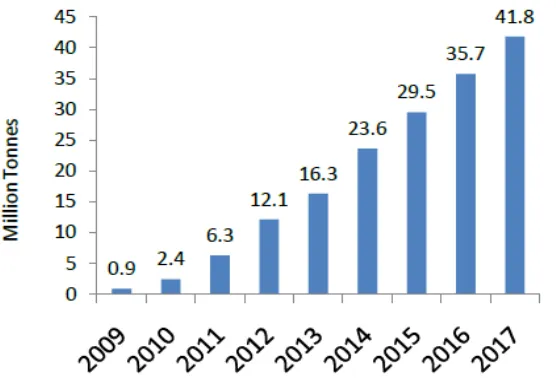http://www.gjaets.com © Global Journal of Advance Engineering Technology and Sciences 6
Global Journal of Advanced Engineering Technologies and Sciences
SWOT ANALYSIS OF MAJOR COAL IMPORT DESTINATIONS FOR
INDIA
Dr. Rohit Verma
*1*1Associate Professor,National Power Training Institute, Faridabad , Haryana
Abstract
Indian coal is inherently of poor quality. Even production of Indian coal is not able to meet the coal demand. India has to import coal for meeting the unsatisfied coal demand or for mixing good quality imported with poor quality Indian coal to improve the overall Gross calorific value of coal. There are various options for importing coal in India. In this paper, SWOT(Strengths, Weaknesses, Opportunities & Threats) analysis of various options of importing coal in India has been done. This may help the industries dependant on imported coal in their decision making for selecting coal importing destinations.
Keywords: coal import, coal demand, SWOT, coal demand.
Introduction
Indian coal is inherently of poor quality. Even production of Indian coal is not able to meet the coal demand. India has to import coal for meeting the unsatisfied coal demand or for mixing good quality imported with poor quality Indian coal to improve the overall Gross calorific value of coal. The average quality of the Indian coal is not very high this necessitates the import of high quality coal to meet the requirements of steel plants. Chandra et al said fossil fuels is going to remain the primary source of energy in India[1]. Coal is likely to remain a key energy source for India, for at least the next 30–40 years, as India has significant domestic coal resources (relative to other fossil fuels) and a large set of existing installed base of coal-based electricity capacity [2]. India’s coal reserves are not as large as previously thought, at the current usage rate, India’s reserves would be depleted in 80 years and at the projected rate of growth in production, that number becomes 40years [3]. India’s main conventional energy resource that is coal, Oil and natural gas are available in limited quantities [4]. In India, the demand and consumption of coal have grown enormously which is primarily dominated by the electricity sector. Since 1970, the demand for coal has increased due to the rapid installation of thermal power plants. In India, the demand and consumption of coal have grown enormously which is primarily dominated by the electricity sector. Since 1970, the demand for coal has increased due to the rapid installation of thermal power plants. Despite huge allocation of coal reserves in the country, it is required to import it from other countries [5]. There has been an increasing trend in the import of coal. Import of coal has steadily increased from 54.04 MTs during 2007-08 to 105.6 MTs during 2011-12. For FY 2013-14, the coal imports touched 171.15 Million Tonnes (MTs). The Combined annual growth rate (CAGR) of Gross Coal imports of India over these 7 years are 17.9%. There was an increase of 17.9% in gross import and 18.61% in net imports of coal in 2013-14 over the previous year. India has been majorly importing coal from Indonesia, South Africa, USA, Mozambique and Australia. Figure 1 shows the Gross and net coal imports in the last seven years in million tons. India is the fourth largest coal importer in the world. India imports 27% of total coal produced in Indonesia, the largest for Indonesia. Shipments of thermal coal used for power generation could rise about 14% to 152 MT this year
http://www.gjaets.com © Global Journal of Advance Engineering Technology and Sciences 7
Figure 1: Coal Imports in India
Source: Annual Report of Ministry of Coal
Figure 2: Percentage break-up of Coking coal, Non-coking coal and coke Import
Source: Ministry of Coal
Country Wise Imported Coal Quality, Specification And Swot Analysis
INDONESIA
http://www.gjaets.com © Global Journal of Advance Engineering Technology and Sciences 8
Figure 3: Indonesian Coal reserves
Source: Handbook of Energy and Economic Statistics, Indonesia, 2012
In Indonesia around 62 percent of the coal reserves are of the quality of medium quality (5100 - 6100 kcal/kg), 24 percent of low quality(less than 4100 kcal/kg), 13 percent of high quality (6100 - 7100 kcal/kg) and 1 percent of very high quality (greater than 7100 kcal/kg).
Figure 4: Indonesian Coal Percentage wise share vis-à-vis quality specification
Source: MEMR, Indonesia
Table 1: Indonesian Coal Quality Specification as per Coal spot.com
Coal Brand (Basic Coal Brand)
GCV (GAR) TM (GAR) Total Sulphur Ash Prima Coal Pinang 6150 Melawan Coal Jarang J-1 Indominco IM East Gunung Bayan1 EnviroCoal EcoCoal 6,700 6,200 5,400 4,400 5,700 7,000 5,000 4,200 12.00 14.50 22.50 32.00 17.50 10.00 26.00 35.00 0.60 0.60 0.40 0.25 1.63 1.00 0.10 0.18 5.00 5.50 5.00 4.15 4.80 15.00 1.20 3.90
Table 2: Indonesian Coal Quality Specification as per Directorate General of Mineral, Indonesia
Product Type of
http://www.gjaets.com © Global Journal of Advance Engineering Technology and Sciences 9 Indonesi an “A” Bitumin ous 570 0 620 0
18 10 0.9 40
Indonesi an “B” Bitumin ous 560 0 610 0
19 8 0.6 40
Indo Sub-bit 1 Sub-Bitumin ous 470 0 565 0
30 8 0.5 44
Indo Sub-bit 2 Sub-Bitumin ous 470 0 565 0
30 8 0.5 44
Indo Low Q 1
Sub-Bitumin ous 470 0 555 0
36 8 0.5 45
Indo Low Q 2
Sub-Bitumin ous 400 0 530 0
39 8 0.5 45
SWOT Analysis of Indonesian Coal
Strengths
1. Nearest To India - Logistics Rates will be lower. 2. Good Connectivity to Port.
3. Internal Rivers- Tug Pulling Barge system. 4. Floating Transshipment Facilities of 170 Mtpa
Weakness
1. Poor in Quality compared to other countries. 2. Poor Land Transportation in Indonesia
Opportunities
Sumatra is Very Close to India and still a lot of mine resource is available to explore
Threats
1. Uncertainties in Government regulations.
2. Prone to natural calamity like earthquake & Tsunami. 3. Other countries also eying the reserves
AUSTRALIA
http://www.gjaets.com © Global Journal of Advance Engineering Technology and Sciences 10
Figure 5: Australian Coal reserves
Source: Australia's Identified Mineral Resources 2012, Australian Government
Table 3: Australian Coal Quality
Coal Quality GC V (kcal/kg)
GC V (kcal/kg)
% Total Moisture (ARB)
% Volatile Matter
%ASH % Sulphur
Southern 6750 6390 6.4 20.8 19.5 0.45
Western 6600 6220 8 28.7 20.4 0.55
Hunter 6810 6360 9.1 32.7 13.5 0.6
Newcastle 6760 6330 8.5 30.6 15.1 0.6
Gunnedah 7050 6515 9 26.8 17.5 0.65
Source: Global Coal.com
SWOT Analysis of Australian Coal
Strengths
1. Maximum Coal mines are of rich quality of around 6000 - 6600 Kcal/kg. 2. Good Port Capacity of around 420 Mtpa.
3. All coal mines are located close to Ports.
Weakness
1. Longer sea distance to India
2. Poor weather Conditions leads to longer Turnaround days for the ships. 3. Need to keep more Inventory due to longer travel time
Opportunities
1. Surat Railway Basin link and Northern Missing link will improve the Rail capacity.
Threats
2. Mining Resource Rent Tax 3. Carbon Tax
http://www.gjaets.com © Global Journal of Advance Engineering Technology and Sciences 11
SOUTH AFRICA
As per BP Statistical Review of World energy 2013, South Africa has huge coal reserves of 30156 Million Tonnes encompassing a total of 3.5 % share of the world's total coal reserves. About 77 percent of South Africa's primary energy needs are provided by coal addition to the extensive use of coal in the domestic economy, about 28 percent of South Africa's production is exported, mainly through the Richards Bay Coal Terminal. 92% of coal consumed on the African continent is produced in South Africa.
Figure 6: South African Coal Reserves in MT
Source: Council of Geoscience, Republic of South Africa
South African Coal mining companies are: Ingwe Collieries Limited, a BHP Billiton subsidiary,Anglo Coal,Sasol, Eyesizwe; and Kumba Resources Limited, accounting for 85 percent of the saleable coal production. Production is concentrated in large mines, with 11 mines accounting for 70 percent of the output. South African coal for local electricity production is among the cheapest in the world. The beneficiation of coal, particularly for export, results in more than 65Mt of coal discards being produced every year. The largest coal deposits in South Africa are to be found in the Ecca Group, a stratum of the Karoo Super group, dating from between 280 and 250 Ma. The Ecca Group is extensive, covering around two thirds of South Africa and contains more than a third of all coal reserves in the Southern Hemisphere. Notable coalfields in South Africa are: Waterberg Coalfield, Highveld Coalfield, Witbank Coalfield, Ermelo Coalfield, Utrecht Coalfield, Klip River Coalfield.
Table 4: South African Coal Grade Specification
Calorific Value Basis (kcal/kg NCV)
Calorific Value Min (kcal/kg NCV)
Total Moisture (ARB
Volatile Matter (ARB)
Ash (ARB)
Sulphur (ARB)
HGI Nominal Topsize
6000 5850 15%max 24-35% 15% max 1%max 45-70 50mm
6700 6200 10% 24% 15%max 0.90% 45 50mm
Source: Globalcoal.com
SWOT Analysis of South African Coal
Strengths
1. Coal for Export is available after Washing- A homogeneous Product 2. Close to the West Coast of India
http://www.gjaets.com © Global Journal of Advance Engineering Technology and Sciences 12
Weakness
1. Even though RBCT is of 91 Mtpa but the rail capacity is 62 Mtpa only. 2. Rail Network is operating at Full Capacity
Opportunities
1. By product from coal washery can be sold to local Power Producers. 2. Coal from Waterberg is still to be tapped.
Threats
1. Local electricity market is heavily dependent on coal, so possibility for export Cap in future. 2. Uncertainty in their railway expansion
MOZAMBIQUE
Mozambique is one of the African country located near to South Africa and is having a small amount of coal which are yet to be explored. After the end of civil war 1993 the country has a stable government and the country is moving in the developing path. The coal reserves in Mozambique are mainly distributed in the Tete province which is located at the centre of the Mozambique. So far three major coal fields has been identified in the Tete province which are
1. Benga Coalfield 2. Moatize Coalfield 3. Zambeze Coalfield
According to the National director of Mines, Mozambique, there is a possibility of coal reserves in the Maniamba basin in Lago district, in the Northern Province of Niassa.
Figure 7: Mozambique Coal production in million Tons
Source: KPMG report on Mozambique mining
Mozambique has Corporate Income Tax at the rate of 35%, 50% reduction is allowed for a period of ten years from the start of production. For invesing in coal mining sector in Mozambique, there is an added advantage that there is a Memorandum of Understanding (MoU) for co- operation for development of coal mining between Government of India and Government of Mozambique.
http://www.gjaets.com © Global Journal of Advance Engineering Technology and Sciences 13
GCV (Kcal/kg) 6000
% Ash 22
% Moisure 8
% Sulphur 0.8
SWOT Analysis of Mozambique Coal
Strengths
1. Coal quality for Export is of up to 6700 Kcal/kg
2. Compared to South Africa 600 Nautical miles closer to India 3. Fastest growing African Country
4. Politically stable since 1992 after the civil war
Weakness
1. Under developed Infrastructure
2. Lack of skills and low productivity of Labor 3. Lack of Proper geological Data about the resources
Opportunities
1. Internal logistics through Zambezi River will reduce the transportation cost to Port
2. Opportunities for Mine mouth Power Plant which can supply to the power starving South African power Pool Market.
3.
Threats
1. New & Small Market.
2. High population of Tribal people.
3. Small country & Uncertainty about regulatory development.
Conclusion
There are various options for importing coal in India. India has been majorly importing coal from Indonesia, South Africa, USA, Mozambique and Australia. In this paper, SWOT(Strength, Weakness, Opportunity & Threat) analysis of various options of importing coal in India has been done. This may help the industries dependant on imported coal in their decision making for selecting coal importing destinations.
References
1. Chandra A, Chandra H, “Impact of Indian and Imported coal on Indian thermal power plants”, Journal of Science & Industrial Research, February 2004, Vol.63, 156-162.
2. Ananth P. Chikkatur, Ambuj D. Sagar, T.L. Sankar, “Sustainable development of the Indian coal sector”, Energy, Elsevier, 2009, Vol. 34, 942–953
3. CH. Venkataiah, Santhosh B. S, “India's Future Consumption Of Coal Resources & Indonesia As A Potential Procurement Destination”, International Journal Of Research In Commerce, Economics & Management,September 2011, Vol. 1 , Issue 5, 87-93.
4. Kirit Parikh, “Sustainable development and low carbon growth strategy for India”, Energy, Elsevier, 2012, Vol. 40, 31–38.
5. Shadman Hussain, Qaisara, Md Aquil Ahmad, “Production, Consumption and Future Challenges of Coal in India”, International Journal of Current Engineering and Technology, October 2014, Vol.4, No.5, 3437-3440.
6. Ministry of Coal - www.coal.nic.in 7. Ministry of Power - www.powermin.nic.in 8. CIL - www.coalindia.in
http://www.gjaets.com © Global Journal of Advance Engineering Technology and Sciences 14
11. KPMG International - Mozambique-mining-country-guide.pdf 12. www.worldcoal.org
13. Australia's Identified Mineral Resources 2012, Australian Government
